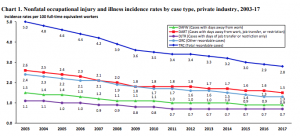Two important data points hit the news this week, both worthy of your attention.
First, BLS data indicates private industry employers reported 47,000 fewer occupational injuries and illnesses in 2017 compared to the previous year, a decrease of about 1.7 percent.
The rate, or frequency of total reportable cases declined by 0.1 cases per 100 FTE. As we’ve reported in the past, BLS data does not precisely mirror work comp claims – but it’s very close.
(Note this does NOT include public sector employer data)
So, occupational injuries and illnesses, along with work comp claims frequency, both dropped last year.
Next, insurer CNA CEO Dino Robusto said this in CNA’s earnings call:
we’ve been seeing negative sort of mid single-digit frequency trends over the past several quarters, which is less negative than a year ago. Now, while we’ve seen some pockets, where frequency has increased, the negative frequency trend overall is still favorable to our long run trend assumptions, because we did not lower our long run frequency assumptions despite the actual frequency consistently more negative than our assumption. [emphasis added]
(thanks to SeekingAlpha for the transcript)
Recall the Hartford has seen an uptick in claims frequency of late, one their CEO opined is not unique to his company.
I checked on other major workers’ comp insurers, including the Travelers, and AIG and did not find anything useful pertaining to frequency or claim counts.
So, what does this mean for you?
Watch your claim frequency carefully, especially in geographic areas and business sectors where hiring is very tough. It could be you’ll see an uptick in claims, due probably to compromises in hiring due to the tight labor market.



in the five years since 2012, BLS lost day injury frequency declined by an annual average of 3.6% and NCCI’s lost time claim frequency declined by an annual average of 4%. there is nothing on the horizon that warns against a reversal of these trends.